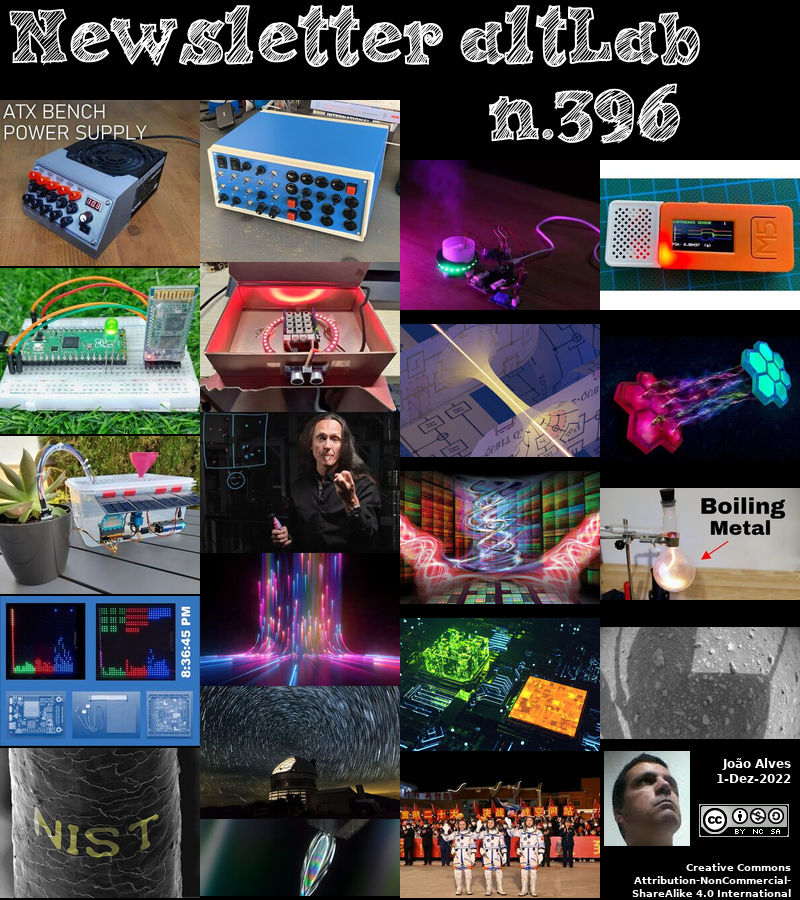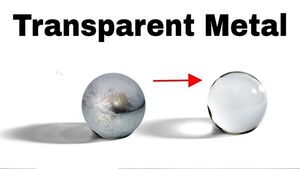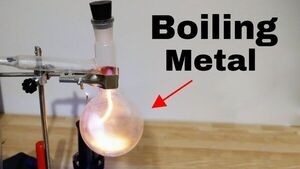2022-12-01 - Nº 396
Editorial
Esta é a Newsletter Nº 396 que se apresenta com o mesmo formato que as anteriores. Se gostar da Newsletter partilhe-a!
Todas as Newsletters encontram-se indexadas no link.
Esta Newsletter tem os seguintes tópicos:
Faz hoje anos que nascia, em 1743, o químico alemão Martin Heinrich Klaproth. Ele é considerado o fundador da química analítica, tendo descoberto o urânio (1789), zircónio (1789), cério (1803), e contribuído para a identificação de outros. Embora não os tenha isolado como amostras de puro metal, foi capaz de os reconhecer como novos elementos. Aos 16 anos, foi aprendiz de boticário. Depois de ler química em Hanover, instalou-se em Berlim (1771) e começou a sua própria loja de boticário (1780). No final de 1780, era o principal químico analítico da Europa. Klaproth encontrou formas de tratar compostos particularmente insolúveis, teve o cuidado de evitar a contaminação pelo seu aparelho, e insistiu significativamente em relatar "pequenas" discrepâncias de peso no trabalho analítico como resultados consistentes.
Faz também hoje anos que nascia, em 1792, o matemático russo Nikolai Lobachevsky. Ele, com János Bolyai da Hungria, é considerado o fundador da geometria não-euclidiana. Lobachevsky construiu e estudou um tipo de geometria em que o postulado paralelo de Euclides é falso (o postulado afirma que através de um ponto não numa determinada linha apenas uma linha pode ser desenhada não encontrando a primeira linha). Isto não foi bem recebido no início, mas a sua maior justificação veio com o advento da teoria da relatividade de Einstein quando foi demonstrado experimentalmente que a geometria do espaço não é descrita pela geometria de Euclides. Além da geometria, Lobachevsky também fez um importante trabalho na teoria das séries infinitas, equações algébricas, cálculo integral, e probabilidades.
Faz igualmente hoje anos que nascia, em 1905, o físico norte-americano Clarence Zener. Ele foi o primeiro a descrever a propriedade relativa à interrupção dos isoladores eléctricos. Estas descobertas foram posteriormente exploradas pelos Laboratórios Bell no desenvolvimento do díodo Zener, que recebeu o seu devido nome. Zener era um físico teórico com formação em matemática que conduziu investigação numa vasta gama de assuntos, incluindo: supercondutividade, metalurgia, ferromagnetismo, elasticidade, mecânica da fractura, difusão, e programação geométrica.
Faz também hoje anos que nascia, em 1925, o bioquímico norte-americano Martin Rodbell. Ele recebeu o Prémio Nobel da Fisiologia ou Medicina de 1994 pela sua descoberta nos anos 60 de transdutores de sinal naturais chamados G-proteínas que ajudam as células do corpo a comunicar entre si. Partilhou o prémio com Alfred G. Gilman, que mais tarde provou a hipótese de Rodbell, isolando a proteína G, assim denominada porque se liga a nucleótidos chamados difosfato de guanosina e trifosfato de guanosina, ou PIB e GTP. Antes da investigação de Rodbell, os cientistas acreditavam que apenas duas substâncias - um receptor hormonal e uma enzima celular interior - eram responsáveis pela comunicação celular. Rodbell, contudo, descobriu que a proteína G actuava como um transdutor de sinal intermédio entre as duas.
Faz igualmente hoje anos que nascia, em 1940, o engenheiro electrotécnico norte-americano Jerry Lawson. Ele é conhecido pelo seu trabalho na concepção da consola de videojogos Fairchild Channel F, bem como por liderar a equipa que foi pioneira no cartucho comercial de videojogos. Foi assim apelidado de "pai do cartucho de videojogos", segundo a revista Black Enterprise em 1982. Acabou por sair da Fairchild e fundou a empresa de jogos Video-Soft.
Por fim, faz hoje anos que nascia, em 1941, o físico norte-americano Stephen Benton. Ele foi pioneiro em imagem médica e holografia de belas artes. O seu fascínio pelos fenómenos ópticos começou com os óculos 3-D que usou quando tinha 11 anos para ver o filme House of Wax, de 1953. Em 1968, inventou os "hologramas arco-íris", vistos em cartões de crédito enquanto trabalhava para a Polaroid Corporation. Voltou-se para a academia como professor assistente em Harvard (1968) e mais tarde como professor no Massachusetts Institute of Technology a partir de 1985, onde ajudou a criar o Spatial Imaging Group e dirigiu o programa de arte e ciências dos media M.I.T. Benton foi pioneiro na holografia da luz natural como meio artístico, e foi curador no Museu de Holografia em Manhanttan até ao seu encerramento em 1992.
Em 1997, oito planetas do nosso Sistema Solar alinharam-se de Oeste para Leste, começando por Plutão, seguido por Mercúrio, Marte, Vénus, Neptuno, Urano, Júpiter e Saturno, com uma lua crescente ao lado, num raro alinhamento visível da Terra que durou até 8 de Dezembro. Mercúrio, Marte, Vénus, Júpiter e Saturno são visíveis a olho nu, sendo Vénus e Júpiter, de longe, os mais brilhantes. É necessário um bom par de binóculos para ver os pequenos pontos azuis que são Urano e Neptuno. Plutão é visível apenas por telescópio. Os planetas também se alinharam em Maio de 2000, mas demasiado perto do sol para serem visíveis da Terra. Passar-se-ão pelo menos mais 100 anos até que tantos planetas estejam tão perto e tão visíveis.
Na Newsletter desta semana apresentamos diversas noticias, artigos científicos, projetos de maker e alguns vídeos interessantes.
 João Alves ([email protected])
João Alves ([email protected])
O conteúdo da Newsletter encontra-se sob a licença  Creative Commons Attribution-NonCommercial-ShareAlike 4.0 International License.
Creative Commons Attribution-NonCommercial-ShareAlike 4.0 International License.
Novidades da Semana
Outras Notícias

STMicroelectronics reveals 100-Watt wireless power receiver for fastest Qi-compliant charging
"Unique high-power capability boosts mobile user experience, brings new opportunities for medical devices and smart industrial technology STMicroelectronics (NYSE: STM), a global semiconductor leader serving customers across the spectrum of electronics applications, has revealed a wireless power receiver with the industry’s highest available power rating of 100 Watts. Ensuring the fastest wireless charging times in the market today, ST’s new STWLC99 device can recharge high-end smartphones with the largest battery capacity in less than 30 minutes. “Today’s phones are essential for digital living, as well as being a critical business tool for many. Significantly faster charging with our STWLC99 increases their availability and brings extra value to users’ lives,” said Francesco Italia, General Manager, Analog Custom Products Division, STMicroelectronics. “Its unprecedented power also changes the outlook for equipment such as battery-powered industrial tools, medical monitors, medicine pumps, mobile robots, and drones, enabling long runtimes with faster turnaround.” In addition to enhancing user convenience, high-power wireless charging lets designers create industrial products that are free of power sockets and cords, which can deliver various advantages. Eliminating the charging socket can save space and allow sealing against water or dust ingress in challenging environments." [...]

TI expands space-grade product portfolio with radiation-hardened and radiation-tolerant plastic packages for missions from new space to deep space
"Texas Instruments (TI) (Nasdaq: TXN) today announced an expansion in its portfolio of space-grade analog semiconductor products in highly reliable plastic packages for a diverse range of missions. TI developed a new device screening specification called space high-grade in plastic (SHP) for radiation-hardened products and introduced new analog-to-digital converters (ADCs) that meet the SHP qualification. TI also introduced new product families to the radiation-tolerant Space Enhanced Plastic (Space EP) portfolio. Compared to traditional ceramic packages, plastic packages offer a smaller footprint that enables designers to reduce system-level size, weight and power, and thus help reduce launch costs. In the past, space applications and programs used hermetically sealed, ceramic Qualified Manufacturers List (QML) Class V devices to ensure reliability. Today, applications like those in new space, designed to increase commercial access to space programs through short-term missions in low Earth orbit (LEO), are helping expand communication and connectivity." [...]

Renesas’ New Programmable Clock Generator Delivers Industry’s Best Combination of Programmability, Power, Jitter, and Size
"New VersaClock® 7 Devices from the Timing Leader Enable Users to Configure Frequencies, I/O Levels and GPIO Pins; Available in Space-Saving Packages to Reduce Board Space. Renesas Electronics Corporation (TSE:6723), a premier supplier of advanced semiconductor solutions, today introduced the VersaClock® 7 clock generators, a family of configurable clock generators with an internal crystal oscillator for PCIe and networking applications in high-end computing, wired infrastructure and data center equipment. The VersaClock 7 delivers unmatched flexibility, enabling designers to configure frequencies, Input/Output (I/O) levels, and General Purpose I/O (GPIO) pin functionality. It establishes a new benchmark in combining low power consumption, cost-efficiency, and small package size. “Timing needs can vary greatly between different applications and equipment, and often change during a product design cycle,” said Zaher Baidas, Vice President of the Timing Products Division at Renesas. “VersaClock 7 gives our customers the flexibility to configure multiple design parameters while offering the best value available for their particular performance requirements.” “High levels of integration and the flexibility of programmability helps manufacturers reduce component counts, saving board space and power,” said Susie Inouye, Principal Analyst at Databeans in Reno, Nevada." [...]
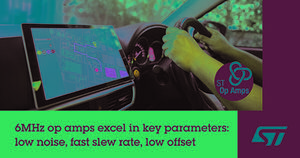
STMicroelectronics boosts all-round performance in op amps for industrial and automotive environments
"STMicroelectronics is simplifying designers’ search for high-performing operational amplifiers (op amps) by introducing three new 6MHz rail-to-rail devices with strong all-round parameters including a wide operating-voltage range and low noise. The TSB511, TSB512, and TSB514 are single, dual, and quad op amps, respectively. They can operate from a single supply in the range from 2.7V to 36V, and with dual supplies from ±1.35V to ±18V. This wide voltage range and flexibility let engineers benefit from applying a familiar op-amp type across various applications and different power domains. The rail-to-rail input and output help ensure suitable dynamic range when operating close to the minimum supply voltage. Input noise density of 12nV/√Hz allows use in circuits where signal integrity is a priority, particularly with weak or wideband signals." [...]

German Federal Printing Office, Fraunhofer and Infineon demonstrate for the first time electronic passport security for the quantum computer era
"Quantum computers could become a serious threat to the security of documents such as electronic passports before the present decade is over. New, quantum-secure encryption methods help protect stored biometric data. At Trustech, the event for innovative payment and identification solutions, Infineon Technologies AG, the German Federal Printing Office (Bundesdruckerei GmbH) and the Fraunhofer Institute for Applied and Integrated Security (AISEC) are presenting the world's first demonstrator for an electronic passport that meets the security requirements of the quantum computing era (Post Quantum Cryptography or PQC). "Today we are launching the encryption procedures which will be needed to repel quantum computer attacks of tomorrow," said Maurizio Skerlj, Vice President and head of Infineon’s Identity Solution Product Line. "Working together with our collaboration partners at the German Federal Printing Office and Fraunhofer AISEC, we have succeeded in efficiently implementing quantum-resistant encryption procedures and making them available for use in practice." The heart of the demonstrator is a security controller from Infineon which protects data from both conventional attacks and attacks that use quantum computers." [...]
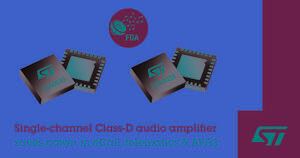
STMicroelectronics’ automotive audio power amplifiers bring digital flexibility to eCall, telematics and AVAS
"The FDA803S and FDA903S are the newest single-channel fully differential 10W Class-D audio power amplifiers in the STMicroelectronics FDA (fully digital amplifier) family. They are designed for automotive applications like eCall, telematics, and wherever an audio channel needs to reproduce human voice, music, or warning messages at a standard output power level of up to 10W. The amplifiers integrate an I2S front end, digital core, 24-bit digital-to-analog converter (DAC) with 100dB resolution, and class-D PWM output stage. The integrated digital audio processing ensures high sound quality within a compact circuit footprint. Feedback within the chip, before the external L-C output filter, simplifies the circuit design and saves space. With full I2C configurability and in-play diagnostics that include clipping detection, thermal warning, overcurrent protection, and open-load detection, both amplifiers minimize external components and bill-of-materials costs." [...]

Mars helicopter Ingenuity aces 1st flight after major software update
"The update will make Ingenuity more capable in hilly terrain. NASA's Mars helicopter Ingenuity has performed its shortest-ever flight, the first after a major software update that will allow the little chopper to land more safely and navigate over rugged terrain. Ingenuity's 34th flight, which took place on Tuesday (Nov. 22), lasted only 18 seconds and saw the helicopter briefly hover after takeoff above Mars' surface before landing just 16 feet (5 meters) away from its starting point. The flight, the first since Sept. 29, was the first try-out of a new software system that was beamed to Ingenuity from Earth to improve its ability to operate in the rugged terrain that its parent Perseverance rover is currently exploring. Ingenuity is an extremely successful technology demonstration, but it was built to navigate in smooth terrain, such as Wright Brothers Field, where it was first deployed in April 2021. The helicopter has been nailing one flight after another, prompting its ground control teams to dare to begin sending the flying robot into more complicated landscapes." [...]

Neuralink demo shows monkey performing ‘telepathic typing’
"Neuralink owner Elon Musk said paperwork for human trials has been submitted to the U.S. Food and Drug Administration (FDA), which he claimed could lead to human trials of the company’s brain-implant technology “in about six months.” Neuralink, which Musk helped to set up in 2016, is developing a system that directly links the human brain to a computer interface. It believes the technology, part of which is implanted directly into the brain, will one day allow the human mind to control gadgets and programs merely through thought, potentially opening up a whole new world for people with brain disorders and conditions such as paralysis. In April 2021, Neuralink demonstrated early trials of the technology by showing a monkey playing a game of Pong just by thinking about it. This time, at a special show-and-tell event held on Wednesday evening, a new video showed a different monkey using thought processes to move a mouse cursor around a keyboard while also making selections to create words. Describing the monkey’s actions as “telepathic typing,” Musk said the demonstration raises the possibility of “someone with no interface with the outside world [being able] to control their phone better than someone who has working hands.” You can watch the monkey in action in the video below: Musk said he believed Neuralink’s technology was now at a point where human trials would be safe, going so far as to say that if one of his own children suffered an accident where Neuralink’s technology could potentially help, he would “feel comfortable” going ahead with the implant, adding, “At least in my opinion, it would not be dangerous.” The Neuralink co-founder has said previously that future, more advanced versions of the technology may even be able to function in a way that will enable paraplegics to walk again. But, of course, regulators will have the final say on its use, with Neuralink hoping to get the green light from the FDA next year to take its technology to the next level." [...]

Chinese astronauts board space station in historic mission
"Three Chinese astronauts arrived on Wednesday at China's space station for the first in-orbit crew rotation in Chinese space history, launching operation of the second inhabited outpost in low-Earth orbit after the NASA-led International Space Station. The spacecraft Shenzhou-15, or "Divine Vessel", and its three passengers lifted off atop a Long March-2F rocket from the Jiuquan Satellite Launch Centre at 11:08 p.m. (1508 GMT) on Tuesday in sub-freezing temperatures in the Gobi Desert in northwest China, according to state television. Shenzhou-15 was the last of 11 missions, including three previous crewed missions, needed to assemble the "Celestial Palace", as the multi-module station is known in Chinese. The first mission was launched in April 2021. The spacecraft docked with the station more than six hours after the launch, and the three Shenzhou-15 astronauts were greeted with warm hugs from the previous Shenzhou crew from whom they were taking over. The Shenzhou-14 crew, who arrived in early June, will return to Earth after a one-week handover that will establish the station's ability to temporarily sustain six astronauts, another record for China's space programme." [...]
Ciência e Tecnologia
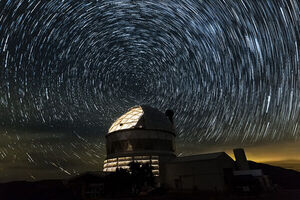
Amateur Scientists Have Helped Astronomers Identify Nearly a Quarter-Million Galaxies
"Astronomers on a historically ambitious and massive galaxy-mapping mission have activated more than 10,000 amateur scientists in 85 countries to help in their quest. Now they hope to significantly scale up their volunteer force for a unique project that could reveal for the first time the nature of dark energy. The research project known as HETDEX, or the Hobby-Eberly Telescope Dark Energy Experiment, is based at The University of Texas at Austin’s McDonald Observatory and relies on volunteers who participate online in a project called Dark Energy Explorers. With a smartphone or computer, participants can experience what it’s like to be an astronomer, teasing apart the mysteries of the universe while helping professional astronomers find distant galaxies and learn more about the mysterious force known as dark energy, which is causing the universe to rapidly expand. Since Dark Energy Explorers launched in February 2021, more than 10,000 volunteers have identified approximately 240,000 galaxies. That amounts to almost one-tenth of the number of galaxies the researchers expect to ultimately find in their survey of a patch of sky that includes most of the Big Dipper and is about the size of 2,000 full moons." [...]

More control over plasma accelerators
"Physicists at the Centre for Advanced Laser Applications at LMU Munich have combined two plasma-based methods of particle acceleration for electron beams. If one particle accelerator alone is not enough to achieve the desired result, why not combine two accelerators? An international team led by physicists at the Centre for Advanced Laser Applications (CALA) at LMU Munich has implemented this idea. It combined two plasma-based acceleration methods for electrons, namely a laser-driven wakefield accelerator (LWFA) with a particle-beam-driven wakefield accelerator (PWFA). With this combination, the physicists achieve better stability and higher particle density for electron beams than with just a single plasma accelerator. The innovative concept therefore opens up new perspectives for plasma-based particle acceleration." [...]
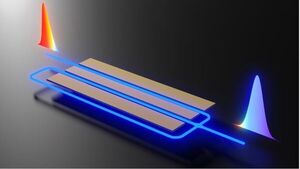
Changing the color of quantum light on an integrated chip
"Device could advance quantum computing and quantum networks Optical photons are ideal carriers of quantum information. But to work together in a quantum computer or network, they need to have the same color — or frequency — and bandwidth. Changing a photon’s frequency requires altering its energy, which is particularly challenging on integrated photonic chips. Recently, researchers from the Harvard John A. Paulson School of Engineering and Applied Sciences (SEAS) developed an integrated electro-optic modulator that can efficiently change the frequency and bandwidth of single photons. The device could be used for more advanced quantum computing and quantum networks. The research is published in Light: Science & Applications." [...]

Soft touch sensitivity
"Compliant and conductive carbon nanomaterial could be the perfect fit for on-skin electronics. A soft and flexible electronic “e-skin,” so sensitive it can detect the minute temperature difference between an inhaled and an exhaled breath, could form the basis of a new form of on-skin biosensor. The ultrathin material is also sensitive to touch and body motion, suggesting a wide array of potential applications. “The skin plays a vital role in our interactions with the world,” says Vincent Tung from KAUST, who led the work. “Recreating its properties in an e-skin could have profound implications for wearable electronics, as well as for sensory prosthetics, soft robotics and human-machine interfaces,” he says. Despite considerable research effort, however, it has been very challenging to create suitable materials, which must be strong and highly sensitive, yet imperceptible when applied to the skin." [...]

Breaking the scaling limits of analog computing
"New technique could diminish errors that hamper the performance of super-fast analog optical neural networks. As machine-learning models become larger and more complex, they require faster and more energy-efficient hardware to perform computations. Conventional digital computers are struggling to keep up. An analog optical neural network could perform the same tasks as a digital one, such as image classification or speech recognition, but because computations are performed using light instead of electrical signals, optical neural networks can run many times faster while consuming less energy. However, these analog devices are prone to hardware errors that can make computations less precise. Microscopic imperfections in hardware components are one cause of these errors." [...]

Mysteriously bright flash is a black hole jet pointing straight toward Earth, astronomers say
"Astronomers have determined the source of an incredibly bright X-ray, optical and radio signal appearing from halfway across the Universe. The signal, named AT 2022cmc, was discovered earlier this year by the Zwicky Transient Facility in California. Findings published today in Nature Astronomy, suggest that it is likely from a jet of matter, streaking out from a supermassive black hole at close to the speed of light. The team, including researchers from MIT and the University of Birmingham, believe the jet is the product of a black hole that suddenly began devouring a nearby star, releasing a huge amount of energy in the process. Their findings could shed new light on how supermassive black holes feed and grow. Astronomers have observed other such “tidal disruption events,” or TDEs, in which a passing star is torn apart by a black hole’s tidal forces." [...]

Busy GPUs: Sampling and pipelining method speeds up deep learning on large graphs
"New technique significantly reduces training and inference time on extensive datasets to keep pace with fast-moving data in finance, social networks, and fraud detection in cryptocurrency. Graphs, a potentially extensive web of nodes connected by edges, can be used to express and interrogate relationships between data, like social connections, financial transactions, traffic, energy grids, and molecular interactions. As researchers collect more data and build out these graphical pictures, researchers will need faster and more efficient methods, as well as more computational power, to conduct deep learning on them, in the way of graph neural networks (GNN). Now, a new method, called SALIENT (SAmpling, sLIcing, and data movemeNT), developed by researchers at MIT and IBM Research, improves the training and inference performance by addressing three key bottlenecks in computation. This dramatically cuts down on the runtime of GNNs on large datasets, which, for example, contain on the scale of 100 million nodes and 1 billion edges. Further, the team found that the technique scales well when computational power is added from one to 16 graphical processing units (GPUs)." [...]

Stabilizing Lithium-Ion Batteries with Microbially Synthesized Electrolyte Additive
"A microbially prepared pyrazine diamine compound significantly stabilizes high-energy density lithium-ion batteries, shows a new study by researchers from Japan Lithium-ion batteries with high-energy-density cathodes are necessary to meet the energy demands of next-generation electronics and electric vehicles. At high voltages, however, the battery electrolyte undergoes excessive decomposition, compromising cathode performance. To tackle this, researchers from Japan have now synthesized a bio-based, non-toxic additive material that stabilizes the cathode by forming a passivation layer on its surface and suppressing its decomposition. Eco-friendly and low-cost, the novel compound could promote a wider utilization of bio-based resources. High energy density lithium-ion (Li-ion) batteries are indispensable for powering electric and hybrid vehicles, next-generation electronics, and power grids. These Li-ion batteries contain high energy density cathodes based on transition metal oxides." [...]

MIT researchers use quantum computing to observe entanglement
"Researchers at the Center for Theoretical Physics lead work on testing quantum gravity on a quantum processor. For the first time, researchers at MIT, Caltech, Harvard University, and elsewhere sent quantum information across a quantum system in what could be understood as traversing a wormhole. Though this experiment didn’t create a disruption of physical space and time in the way we might understand the term “wormhole” from science fiction, calculations from the experiment showed that qubits traveled from one system of entangled particles to another in a model of gravity. This experiment performed on the Sycamore quantum processor device at Google opens the doors to future experiments with quantum computers to probe ideas from string theory and gravitational physics. “Simulating strongly-interacting quantum systems, such as those that arise in quantum gravity, is one of the most exciting applications of quantum computers,” says Daniel Harlow, the Jerrold R. Zacharias Career Development Associate Professor of Physics and a researcher at the MIT Laboratory for Nuclear Science (LNS) who works with David Kolchemeyer, one of the lead authors of the work. “This is a promising initial step.” In a new paper in Nature, a team of physicists, including MIT Center for Theoretical Physics (CTP) and LNS researchers Kolchmeyer and Alexander Zlokapa, presents results on a pair of quantum systems that behave analogously to a traversable wormhole." [...]

Levitating balls and high-speed oscillators to help solve quantum physics problems
"Lancaster University has won a £1.3M award for research into quantum turbulence. The funding from the EPSRC is for a four-year project entitled “Creation and evolution of quantum turbulence in novel geometries”. The research team is led by Professor Peter McClintock with Lancaster researchers Professor Aneta Stefanovska, Dr Dmitry Zmeev and Professor Viktor Tsepelin. International partners include Charles University in the Czech Republic, King Juan Carlos University in Spain and Osaka Metropolitan University in Japan. Turbulence is ubiquitous in the real world and affects almost every aspect of our daily lives, including transport, energy production, climate, and biological processes, but despite its universal importance, it is not well understood. Quantum mechanics often makes complex problems conceptually simpler, and quantum turbulence in super fluids is a prime example." [...]
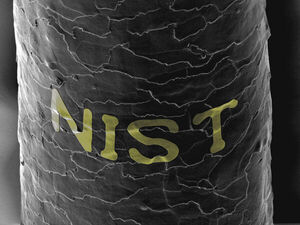
NIST Finds a Sweet New Way to Print Microchip Patterns on Curvy Surfaces
"NIST scientist Gary Zabow had never intended to use candy in his lab. It was only as a last resort that he had even tried burying microscopic magnetic dots in hardened chunks of sugar — hard candy, basically — and sending these sweet packages to colleagues in a biomedical lab. The sugar dissolves easily in water, freeing the magnetic dots for their studies without leaving any harmful plastics or chemicals behind. By chance, Zabow had left one of these sugar pieces, embedded with arrays of micromagnetic dots, in a beaker, and it did what sugar does with time and heat — it melted, coating the bottom of the beaker in a gooey mess. “No problem,” he thought. He would just dissolve away the sugar, as normal." [...]

Graphene heads to the moon
"Cambridge researchers are part of a European project testing graphene’s ability to protect spacecraft against the sticky, sharp dust on the moon’s surface – a challenge for lunar missions since the Apollo era. The Rashid lunar rover will soon be launched from Cape Canaveral in Florida as part of the Emirates Lunar Mission. The rover will land in Atlas crater, a geologically rich but little-explored area on the moon’s nearside – the side that always faces Earth. During one lunar day, equivalent to approximately 14 days on Earth, Rashid will investigate different geological features on the moon’s surface. The rover’s wheels will be used for repeated exposure of different materials to the lunar surface. As part of the Material Adhesion and abrasion Detection (MAaD) experiment, graphene-based composites on the rover’s wheels will be used to understand if this material can protect spacecraft against the harsh conditions on the moon, and especially against lunar dust, or regolith." [...]
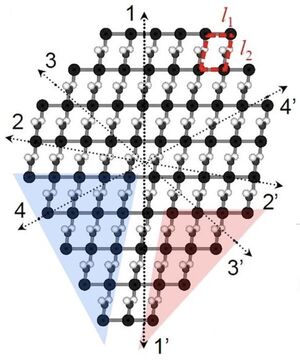
A crystal shape conundrum is finally solved
"Rice theorists’ method can predict shapes of crystals that lack symmetry A crystal’s shape is determined by its inherent chemistry, a characteristic that ultimately determines its final form from the most basic of details. But sometimes the lack of symmetry in a crystal makes the surface energies of its facets unknowable, confounding any theoretical prediction of its shape. Theorists at Rice University say they’ve found a way around this conundrum by assigning arbitrary latent energies to its surfaces or, in the case of two-dimensional materials, its edges. Yes, it seems like cheating, but in the same way a magician finds a select card in a deck by narrowing the possibilities, a little algebraic sleight-of-hand goes a long way to solve the problem of predicting a crystal’s shape. The method described in Nature Computational Science shows using what they call auxiliary edge energies can bring predictions back in line with the Wulff construction, a geometrical recipe in use for more than a century to determine how crystals arrive at their final equilibrium shapes. The open-access paper by materials physicist Boris Yakobson, lead author and alumnus Luqing Wang and their colleagues at Rice’s George R. Brown School of Engineering introduces algorithms that employ arbitrary numbers for the right-hand factors in the equations and still deliver the proper unique shape-solution." [...]
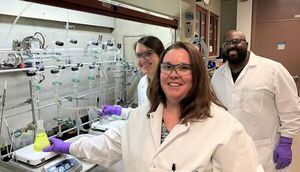
Uranium takes an alternate pathway under extreme conditions
"Under normal conditions, radioactive materials such as uranium work in a predictable manner. But take those same materials and put them under extreme conditions with high temperature in a short timescale and a rapid cooling process and their decomposition pathways change dramatically. Lawrence Livermore National Laboratory (LLNL) scientists built a unique process to synthesize radioactive compounds (uranium-based) that are extremely air- and water-sensitive and require specific techniques. The team was then able to characterize the behavior of these compounds under extreme conditions using a custom-built laser chamber capable of handling radioactive material. This work explored new reaction pathways for thermal decomposition since the reaction rates are so fast and so far from equilibrium processes. The research appears on the cover of the journal Inorganic Chemistry." [...]

uOttawa researchers solve 20-year-old optical light mystery
"It was believed that it was impossible to differentiate the enantiomers of a chiral molecule using helical light beams - until now that is, thanks to a group of uOttawa researchers. For nearly 20 years researchers believed that it was not possible to differentiate the enantiomers of a chiral molecule using helical light beams. Enantiomers are mirror images of a molecule that cannot be superimposed, like our left and right hands that cannot appear identical simply by reorientation. In addition, molecules with symmetrical properties such as achiral molecules are not expected to show any dependence on the helicity of light. Yet this is what a group of researchers at the University of Ottawa have done. The team, led by Professor Ravi Bhardwaj and his PhD students Ashish Jain and Jean-Luc Bégin, with the collaboration of professors Thomas Brabec, Ebrahim Karimi from the uOttawa Nexus for Quantum technology Institute, and Paul Corkum, Canada Research Chair in Attosecond Photonics, developed a new chiroptical technique to differentiate the two non-superimposable mirror images of a chiral molecule." [...]
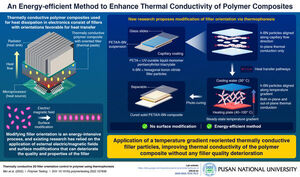
Pusan National University Researchers Introduce an Energy-Efficient Method to Enhance Thermal Conductivity of Polymer Composites
"Thermally conductive polymer composites consist of fillers oriented in certain directions that form pathways for heat flow. However, conventional methods to control the orientation of these fillers are energy-intensive and require surface modifications that can deteriorate the quality and properties of these materials. Now, researchers from South Korea have developed an energy-efficient method to control the orientation of the fillers without the need for surface modification, resulting in improvement in thermal conductivity. Owing to their lightweight nature and flexibility, thermally conductive polymer composites are applied between a heat source and a sink in electronics to dissipate the generated heat to the surroundings. Efficient heat dissipation is achieved due to the use of fillers with certain orientations that facilitate heat flow. The conventional process of modifying the orientation of the filler material, however, is an energy-intensive process that requires the use of electric/magnetic fields and surface modifications that can compromise the filler’s quality and its thermal properties." [...]

Novel 3D Printing Method to Fabricate Complex Metal–Plastic Composite Structures
"Novel 3D Printing Method to Fabricate Complex Metal–Plastic Composite Structures Researchers from Japan and Singapore have developed a new 3D printing technique to create precise patterns on the external and internal surfaces of 3D plastic structures In recent years, research interest in the 3D printing of metal patterns on plastic parts has grown exponentially, due to its high potential in the manufacturing of next-generation electronics. But fabricating such complex parts through conventional means is not easy. Now, researchers from Japan and Singapore have developed a new 3D printing process for the fabrication of 3D metal–plastic composite structures with complex shapes. Three-dimensional (3D) metal–plastic composite structures have widespread potential applicability in smart electronics, micro/nanosensing, internet-of-things (IoT) devices, and even quantum computing. Devices constructed using these structures have a higher degree of design freedom, and can have more complex features, complex geometry, and increasingly smaller sizes. But current methods to fabricate such parts are expensive and complicated." [...]
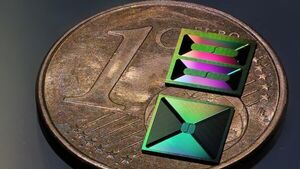
Photonics chip allows light amplification
"Scientists at EPFL have developed photonic integrated circuits that demonstrated a new principle of light amplification on a silicon chip. It can be employed for optical signals like those used in Lidar, trans-oceanic fiber amplifiers or in data center telecommunications. The ability to achieve quantum-limited amplification of optical signals contained in optical fibers is arguably among the most important technological advances that are underlying our modern information society. In optical telecommunications, the choice of 1550 nm wavelength band is motivated not only by loss minima of silica optical fibers (a development recognized with the 2008 Nobel Prize in Physics), but equally to the existence of ways to amplify these signals, crucial to achieve trans-oceanic fiber optical communication. Optical amplification plays a key role in virtually all laser-based technologies such as optical communication, used for instance in data-centers to communicate between servers and between continents through trans-oceanic fiber links, to ranging applications like coherent Frequency Modulated Continuous Wave (FMCW) LiDAR – an emerging technology that can detect and track objects farther, faster, and with greater precision than ever before. Today, optical amplifiers based on rare-earth ions like erbium, as well as III-V semiconductors, are widely used in real-world applications." [...]

New device can control light at unprecedented speeds
"Researchers have developed a programmable optical device for high-speed beam steering. In a scene from “Star Wars: Episode IV — A New Hope,” R2D2 projects a three-dimensional hologram of Princess Leia making a desperate plea for help. That scene, filmed more than 45 years ago, involved a bit of movie magic — even today, we don’t have the technology to create such realistic and dynamic holograms. Generating a freestanding 3D hologram would require extremely precise and fast control of light beyond the capabilities of existing technologies, which are based on liquid crystals or micromirrors. An international group of researchers, led by a team at MIT, spent more than four years tackling this problem of high-speed optical beam forming. They have now demonstrated a programmable, wireless device that can control light, such as by focusing a beam in a specific direction or manipulating the light’s intensity, and do it orders of magnitude more quickly than commercial devices." [...]

Programming tool turns handwriting into computer code
"A Cornell team has created an interface that allows users to handwrite and sketch within computer code – a challenge to conventional coding, which typically relies on typing. The pen-based interface, called Notate, lets users of computational, digital notebooks – such as Jupyter notebooks, which are web-based and interactive – to open drawing canvases and handwrite diagrams within lines of traditional, digitized computer code. Powered by a deep learning model, the interface bridges handwritten and textual programming contexts: Notation in the handwritten diagram can reference textual code and vice versa. For instance, Notate recognizes handwritten programming symbols, like “n,” and then links them up to their typewritten equivalents. In a case study, users drew quantum circuit diagrams inside of Jupyter notebook code cells. The tool was described in “Notational Programming for Notebook Environments: A Case Study with Quantum Circuits,” presented at the ACM Symposium on User Interface Software and Technology, held Oct. 29 through Nov. 2 in Bend, Oregon." [...]

Engineers use quantum computing to develop transparent window coating that blocks heat, saves energy
"Cooling accounts for about 15 percent of global energy consumption. Conventional clear windows allow the sun to heat up interior spaces, which energy-guzzling air-conditioners must then cool down. But what if a window could help cool the room, use no energy and preserve the view? Tengfei Luo, the Dorini Family Professor of Energy Studies at the University of Notre Dame, and postdoctoral associate Seongmin Kim have devised a transparent coating for windows that does just that. The coating, or transparent radiative cooler (TRC), allows visible light to come in and keeps other heat-producing light out. The researchers estimate that this invention can reduce electric cooling costs by one-third in hot climates compared to conventional glass windows." [...]

U-M team recycles previously unrecyclable plastic
"PVC, or polyvinyl chloride, is one of the most produced plastics in the United States and the third highest by volume in the world. PVC makes up a vast amount of plastics we use on a daily basis. Much of the plastic used in hospital equipment -- tubing, blood bags, masks and more -- is PVC, as is most of the piping used in modern plumbing. Window frames, housing trim, siding and flooring are made of, or include, PVC. It coats electrical wiring and comprises materials such as shower curtains, tents, tarps and clothing. It also has a zero percent recycling rate in the United States." [...]
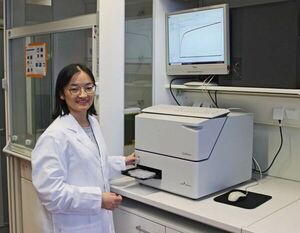
Accelerating plastic degradation in the environment: Bayreuth study researches heat resistance of enzymes
"Numerous plastics are principally biodegradable, but are only degraded very slowly in the open air, wastewater, or composting plants. Known enzymes with the ability to degrade plastics could solve this problem. To do so, however, they must be able to withstand high temperatures. An interdisciplinary team from the Collaborative Research Center "Microplastics" at the University of Bayreuth has now presented new methods in the journal "Biomacromolecules" that are a crucial prerequisite for protecting enzymes from high heat. If enzymes are thermally stable, they can be added to biodegradable plastics during production and later accelerate natural degradation. Numerous commercially available plastics undergo natural degradation processes in the environment and are therefore considered biodegradable." [...]

Quantum leap for Heriot-Watt research into unhackable communications networks
"Scientists at Heriot-Watt University have published ground-breaking research into the phenomenon known as quantum entanglement. This is when two particles – such as photons of light – remain connected even when they’re separated by vast distances. In a world riddled with threats such as cyber-attacks and information leaks, quantum entanglement will allow future communications networks to be unhackable, say researchers at Heriot-Watt’s Institute of Photonic and Quantum Sciences. The technology can deliver the most secure form of communication possible, even if devices are unsafe or in criminal hands. But over long distances, entangled photons can be disrupted by noisy real-world environments, such as stormy weather, background noise, or signal loss in a communications network. Problems like these can jeopardise security in a quantum network." [...]
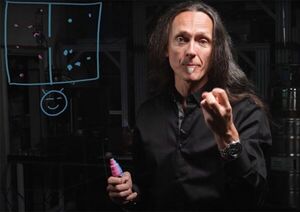
New quantum computing feat is a modern twist on a 150-year-old thought experiment
"UNSW Sydney research demonstrates a 20x improvement in resetting a quantum bit to its ‘0’ state, using a modern version of the ‘Maxwell’s demon’. A team of quantum engineers at UNSW Sydney has developed a method to reset a quantum computer – that is, to prepare a quantum bit in the ‘0’ state – with very high confidence, as needed for reliable quantum computations. The method is surprisingly simple: it is related to the old concept of ‘Maxwell’s demon’, an omniscient being that can separate a gas into hot and cold by watching the speed of the individual molecules. “Here we used a much more modern ‘demon’ – a fast digital voltmeter – to watch the temperature of an electron drawn at random from a warm pool of electrons. In doing so, we made it much colder than the pool it came from, and this corresponds to a high certainty of it being in the ‘0’ computational state,” says Professor Andrea Morello of UNSW, who led the team. “Quantum computers are only useful if they can reach the final result with very low probability of errors." [...]

Reversing the charge
"Battery power from electric vehicles to the grid could open a fast lane to a net-zero future. Owners of electric vehicles (EVs) are accustomed to plugging into charging stations at home and at work and filling up their batteries with electricity from the power grid. But someday soon, when these drivers plug in, their cars will also have the capacity to reverse the flow and send electrons back to the grid. As the number of EVs climbs, the fleet’s batteries could serve as a cost-effective, large-scale energy source, with potentially dramatic impacts on the energy transition, according to a new paper published by an MIT team in the journal Energy Advances. “At scale, vehicle-to-grid (V2G) can boost renewable energy growth, displacing the need for stationary energy storage and decreasing reliance on firm [always-on] generators, such as natural gas, that are traditionally used to balance wind and solar intermittency,” says Jim Owens, lead author and a doctoral student in the MIT Department of Chemical Engineering. Additional authors include Emre Gençer, a principal research scientist at the MIT Energy Initiative (MITEI), and Ian Miller, a research specialist for MITEI at the time of the study." [...]

Shining a new light on oil-slick rainbows and other thin-layer physics
"To invent a new tool for studying how chemicals react at interfaces, researchers shoot tiny jets of oil and water at each other and illuminate them. When sunlight reflects on an oily puddle of water in a parking lot, it creates a rainbow of swirling colors. That's because of the thin film interference principle, which explains how light reflects off of different layers, or films, in a mixture of liquids. For David Hoffman, an associate scientist at the Department of Energy's SLAC National Accelerator Laboratory, however, what's happening in those mixtures is a lot more than just pretty colors. The thin interfaces that produce those colors have major implications across biology, chemistry and the oil and pharmaceutical industries, among others. A key application is in chemical purification, where separating chemicals at their interfaces is at the heart of the process." [...]
Projetos Maker
Diversos Projetos interessantes.

Firewood-free mini fireplace
"A fire-free fireplace allows you to avoid some unnecessary accidental like sparks of the wood ignite the attached hay. There are many accidental fires around the world every year, and one of the reasons is that the sparks from the wood ignite nearby flammable materials, such as hay, dead branches, paper, etc. But if you use some components that have a similar effect, you can avoid some fires that should not happen. So I made a fireplace or campfire without burning any wood. This project uses Seeeduino V4.2 as the main controller and uses a Base shield extension to connect the sensor to the RGB Ring light and then fans the wind (distance) by hand to make the "flame" burn more vigorously. Features - Avoid many things that may cause fire - Easy to start for beginners." [...]
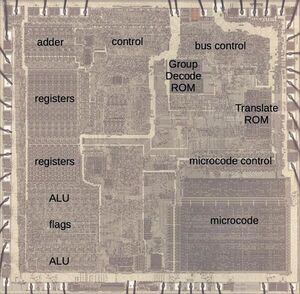
A bug fix in the 8086 microprocessor, revealed in the die's silicon
"The 8086 microprocessor was a groundbreaking processor introduced by Intel in 1978. It led to the x86 architecture that still dominates desktop and server computing. While reverse-engineering the 8086 from die photos, a particular circuit caught my eye because its physical layout on the die didn't match the surrounding circuitry. This circuit turns out to implement special functionality for a couple of instructions, subtlely changing the way they interacted with interrupts. Some web searching revealed that this behavior was changed by Intel in 1978 to fix a problem with early versions of the 8086 chip. By studying the die, we can get an idea of how Intel dealt with bugs in the 8086 microprocessor." [...]

Automatic Humidifier
"An automatic humidifier makes your winter more comfortable Motivation Many people get dry throats, and itchy skin and some even experience nosebleeds every morning due to the unusually dry winter air and the use of heating equipment. By appropriately raising air humidity, several respiratory disorders can be prevented from developing. This project measures the temperature and humidity in your room or workplace to determine whether they are within a comfortable range. If it determines that the relative humidity is below the necessary threshold, it activates the humidifier. " [...]

The ATtiny 2-Series
"This article looks at Microchip's latest addition to the ATtiny range, the 2-series, which offers some key advantages over the earlier ATtiny 0-series and 1-series, including: an advanced 12-bit differential 375 ksps analogue-to-digital converter with a 16x programmable gain amplifier, two USARTS, increased RAM, and the option of a smaller SSOP package for the 14-pin and 20-pin parts. Introduction A couple of years ago I reviewed the ATtiny 0-series and 1-series range of chips from Microchip, an impressive matrix of parts with a consistent set of peripherals, and covering a wide range of application requirements from 8 to 24 pins and 2K to 32K of flash memory (see Getting Started with the New ATtiny Chips). Since then, starting with the ATtiny1624, ATtiny1626, and ATtiny1627 released in Q1 2021, Microchip have been extending the range with a new 2-series. As the full set of parts have now been released I thought it would be useful to update my original article to add information about the new 2-series. " [...]

Sound Disturbance and Temperature Detector for Gamers
"Utilize sensors to monitor sound disturbances and temperature levels in a gaming environment. If thresholds are reached, alerts are sent. Many things can be neglected due to the concentration required for games with the compounded effect of noise-canceling headphones. It is really common for a PC or console to start heating up the room along with human body temperature in a closed environment. In addition to this, loudspeakers can cause the user to be very loud and forget their mindfulness of their roommates. Particle Argons are used in this project to help address this issue whether it is during the day or night." [...]

Brake Light and Turn Signals for Backpacks
"Accelerometer autodetects Braking. The Turn signals are commanded by a 315MHz module. 78 neopixels. Based on Adafruit CPX. The remote of the radiolink is installed on the handlebar. By pressing buttons of one side or another, the turn signals are light up." [...]

MikroLeo
"MikroLeo project files (schematic, PCB, assembler, emulator/debugger, circuit simulation file, documentation, example of programs etc). MikroLeo is a 4-bit microcomputer developed mainly for educational purposes and distributed for free under open-source licenses. 4-bit Didactic Microcomputer The project is in the final testing stage. This project was developed mainly for educational purposes. I hope it will be a good learning platform for anyone who likes electronics, computers and programming. Since my first attempts, many efforts have been made to make this project real." [...]

Blackout Logger
"Hardware - Raspberry Pi Pico - Precision RTC Module (DS3231) - Waveshare eink 3.7 Software MicroPython The software is written in MicroPython 1.19.1 - Download the MicroPython UF2. - Push and hold the BOOTSEL button and plug your Pico into the USB port of your computer. Release the BOOTSEL button after your Pico is connected. - It will mount as a Mass Storage Device called RPI-RP2. - Drag and drop the MicroPython UF2 file onto the RPI-RP2 volume. " [...]

Automatic Watering System Using Pico:ed V2
"This time I present you an useful and affordable project very easy to build by our kids. It is an automatic watering system controlled by a Pico:ed V2 board. How it works: when the soil moisture sensor detects the soil is not moist enough (sad image), send a signal to a water pump to begin to water the plant (cry image). It only will happen if the water level sensor installed detects there is enough water in the plastic bowl to prevent the water pump damage. If the soil is moist enough, the board shows a smile image. By the other hand, if we keep pushing the button A, we can set up the number of seconds the water pump is watering the plant, from 1 to 10 seconds, and if we push the button B, the water pump will begin to watering the plant the number of seconds configured without taking into account the soil moisture." [...]

PEMF Therapy device experiments - general description, build
"I will describe to you the simplest way so far, to make PEMF device yourself and try the effects of this type of therapy. Pulsed ElectroMagnetic Field therapy, also known as PEMF, is a drug-free, non-invasive, pain-relief alternative treatment, which also promotes accelerated healing for ailments and injuries. PEMF therapy improves sleep, mental focus, and the body's overall performance by helping the energy output and regeneration of the body's cells. In several of my previous videos, I described ways to make such a device yourself. Due to the great interest and many questions that were asked to me in the previous period, I decided to make this video in which I will try to explain the working principle and its components in a very simple way, so that those readers who only have basic technical knowledge could understand what it is about. I will also describe to you the simplest way so far, to make such a device yourself and try the effects of this type of therapy." [...]
The Circle of Life (a digitless, pixeldust clock)
"Measuring time using rhythms, pulses and gravity with an animated 32x32 RGB LED matrix The Circle of Life Entropy dictates that all ordered structures will eventually collapse. This includes the collapse of life. Hope, then, hangs on the cycles of creation and destruction, allowing for the resiliency of life. Water, earth, light and heat, the pillars on which life rests, pulse with specific rhythms, creating cycles that begin and end. These cycles and rhythms are what we use to measure the passage of time. The Object of Design Water, or rather ice water, pulses every second, depositing a water particle on top with every pulse." [...]

How to Use HC-05 Bluetooth With Raspberry Pi Pico Using Micropython
"This guide covers how to use the HC-05 Bluetooth module with a Raspberry Pi Pico board using MicroPython. The HC-05 is a Bluetooth module that can be used to wirelessly communicate with other Bluetooth devices, such as smartphones, laptops, and other microcontrollers. You need to ensure that you have the following components below before going through this tutorial. - Raspberry Pi Pico - HC05 Bluetooth Module - Jumper Wire - Breadboard" [...]
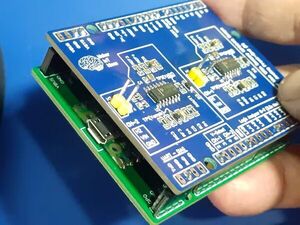
RP2040 Oscilloscope Analog Front-end
"An analog Frontend shield for the Scoppy Oscilloscope, running on the RP2040 This post will look at my prototype Analog front-end for the Scoppy RP2040 Oscilloscope. It is important to state right from the beginning that this circuit is one of the 5 recommended designs from the Scoppy Website. I have only moved it from the breadboard design as published, onto a PCB. The entire circuit, with all of the original designer’s writeups, is available here So, why use someone else’s circuit? Well, the reason for this is two-fold.1) The circuit designer also designed the firmware, so it stands to reason that his circuit will be optimised for use with the firmware.2) Using his circuit provides a solid reference, making it possible to test the firmware for correct operation, and later on, providing a base for my own design – if and when I do decide it is worthwhile to actually design my own.As I already have a proper oscilloscope as well as a logic analyser, this entire exercise is purely academic, I find the Scoppy project interesting, and as such, I would like to see how it compares with my commercial products ( while also knowing that it won’t be a very fair comparison ).With all the limitations, I am however still quite impressed at the level of use that you can get out of this very simple device. It is definitely quite useful for a beginner." [...]
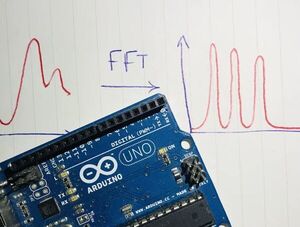
Faster Than the Fastest FFT for Arduino
"The Fast Fourier Transform (FFT) is an efficient algorithm to compute the discrete Fourier transform of a signal. If you search for algorithm implementations, you will find this great Instructable. However, while it provides an effective way to implement the FFT, it is possible to be even more efficient while keeping a high precision. In the present Instructable, I propose to re-use the implementation I made in Julia here (English version available here on my blog) to beat ApproxFFT. Let's dig in! What Is the Main Difference With ApproxFFT ?" [...]
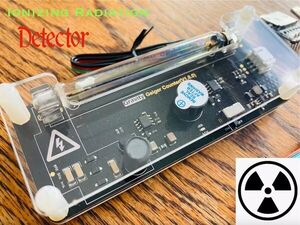
Ionizing Radiation Detector
"This tutorial is for building an ionizing radiation detector with Arduino! Hello! I decided to build this project because ionizing radiation can be dangerous, and it is very hard to know if it's there. I am hoping this project will help people be able to create their own ionizing radiation detectors for relatively cheap! How Ionizing Radiation Works The definition of ionizing radiation is "radiation consisting of particles, X-rays, or gamma rays with sufficient energy to cause ionization in the medium through which it passes." This includes air, water, and living tissue." [...]

Rebuilding IC555 - Astable Multivibrator
"This Astable multivibrator is used to generate the PWM signal. Basically a rectangular signal of variable duty cycle and frequency. 555 timer is one of the most advanced and most popular IC of it’s time. This IC has a lot of configurations and circuit arrangements. We can design some small sections of a circuit using this IC without using any microcontroller. This IC has some applications in generating square wave up to 500khz with an adjustable duty cycle, generating precise time delays under monostable mode, bistable mode to make a two-latch switch configuration and Schmitt trigger." [...]

Flight Simulator Switch Panel for Xbox/PC
_"For the casual flight simmer, a peripheral device that sits somewhere between arcade and realism. Hopefully this will inspire someone to make something cool! How it works: I built this device to work with Microsoft Flight Simulator on the Xbox series S, although I suspect it should work for PC as well. The main idea here is to use a USB compatible Arduino (or other microcontroller), to emulate a standard old keyboard and thus send instruction to the game via key commands. We can accomplish this using the Arduino Keyboard library. **You MUST use a USB compatible board for this."_ [...]

Getting real-time position using MPU9250
"MPU-9250 is one of the most advanced combined accelerometer, gyroscope and compass small size sensors currently available. It replaces the popular MPU-9150 lowering the power consumption, improving gyro noise and compass full scale range performance. It has many advanced features, including low pass filtering, motion detection and even a programmable specialized processor. Internally it includes the MPU-6500, which contains a 3-axis gyroscope plus a 3-axis accelerometer, and the AK8963, the market leading 3-axis digital compass. The MPU-9250 uses 16-bit analog-to-digital converters (ADCs) for digitizing all 9 axes. The MPU-9250 is a high performance accelerometer, gyroscope and magnetometer option for use in applications such as gesture recognition, self-balancing robots, cell phones, fitness monitoring and similar applications where detection of movement direction and magnitude along with rotation is desired." [...]

12V DC Motor Controlled By Adafruit TB6612 Motor Driver
"This Arduino code controls a 12V DC motor (linear actuator) using an Adafruit TB6612 1.2A DC Motor Driver and external 12V power supply. For this project, I wanted to control a motor, specifically a linear actuator (with linear motion), using a 12V power supply. For this to work, I found that I needed an Adafruit TB6612 motor driver breakout board in addition to the Arduino Uno board. This driver can control 2 DC motors, or 1 stepper motor (a DC motor usually has 2 wires, while a stepper motor has more than 2 wires coming out of it). Since I had difficulty finding a good Adafruit wiring diagram for a DC motor (with two wires coming out of it), I've made one here for you with Fritzing! For this tutorial, I am using a 12V DC motor (a stepper motor would also work but would require different wiring, explained on the Adafruit.com TB6612 tutorial)." [...]
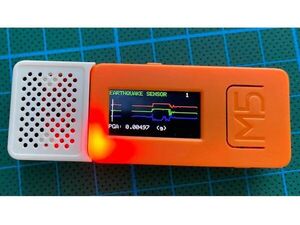
SeismoM5 Earthquake Sensor
"An MQTT Earthquake Seismc Sensor with M5StickC and SPK HAT Living in a highly seismic activity city brings its own challenges. Waking up in the middle of the night with a shake and wondering the epicenter and magnitude of the earthquake, praying that everyone you love is safe etc. You start browsing through each of the Seismology networks to get a little bit more knowledge about it but you have to wait at least some minutes to get some reliable information about this specific earthquake. Having a smart home with lights, rolling shutters, lots of sensors, actuators etc., an earthquake sensor was the missing piece. If only there was an affordable sensor which will activate during an earthquake and gives audio and visual warning, shut off gas valves, open some doors, rolling shutters and lights for a safe escape route. A professional or amateur grade seismograph or structural vibration sensors were out of question for me since I am nowhere near being a seismologist or do I have the time to analyze the output of these sensors." [...]

Midbar (ESP8266 Version)
"A while ago, I made the ESP32 version of Midbar which later evolved into a multi-user Cipherbox. While developing the Cipherbox, I realized that even the Lite version of it might be too expensive and too redundant for some people, so I "resurrected" the single-user Midbar project and made an ESP8266 version of it. The purpose of Midbar is to significantly increase the cost of unauthorized access to its user's personal data. ESP8266 version of Midbar utilizes the 3DES + AES + Blowfish + Serpent encryption algorithm alongside the ESP8266's built-in memory to store eight passwords and four credit cards in the encrypted form. It also utilizes the HMAC SHA-256 to verify the integrity of the stored logins, which means that if at least one bit of an encrypted login gets flipped, Midbar will inform you about it by displaying the following alert: "Integrity Verification Failed!!!" In case you've missed the original Midbar or just want to know why I called it Midbar in the first place - Midbar (מדבר) is a Hebrew word that means "pasture," "uninhabited land," "wilderness," "large tracts of wilderness (around cities)," "desert."" [...]

ATX Bench Power Supply
"In this instructable I'll show you how to turn a working ATX PSU into a bench power supply. For this design I got a lot of inspiration from similar projects. Note: before starting this project make sure the power supply is unplugged and turned off. For this project you will need the following parts and tools: Parts: - ATX power supply x1 - Female Banana Plugs x10 - 5x20 Fuse panel mount x5 - 5x20 Fuse (value depends on your power supply) x5 - 5Ω 10W Resistor x1 - Perfboard x1 - Multi-turn Potmeter x1 - Voltage meter x1 - On/Off Switch x1 - Step-down Buck Converter XL4005 5A x1 - M3x5x5 3D-print inserts x8 - M3 screws x8 Tools: - 3D printer - Soldering iron - Wire Strippers - Cutting pliers - Screwdriver - Super glue" [...]
Secção Videos
Videos interessantes.
That's all Folks!



